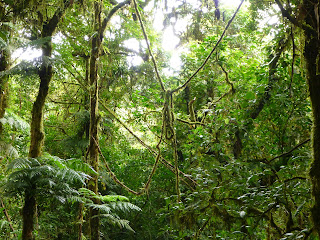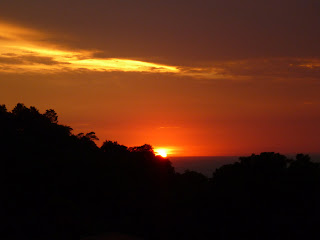Monteverde offers a great way to explore the cloud forest: a series of hanging bridges takes you on a trail through the forest, offering the opportunity to see different levels of the forest up close. Since cloud forest is a very dense and humid forest, the vegetation changes as you go higher up in the forest: the plants needing more light only grow on the upper levels.
The hanging bridges also allow you to look down on some of the lower levels, revealing such beautiful sights as this star-shaped fern:
Just to give you an impression of the hanging bridges, they varied in length between 50 and 150 meters, and in height between 20 and 35 meters. This is one of them photographed from below - you can really see how it takes you through a different level of the forest.
The bridges were very stable, but still, it had taken me a few days to convince my mum to consider hanging bridges at all. Once we were there, however, she enjoyed the bridges and the views very much - just another piece of evidence that fear of heights isn't a permanent condition :-). From above, the bridges looked like this:
Walking along the trail with open eyes, there were new plants to discover every few meters and so we stopped all the time to take pictures. We would have driven any guide mad with our lack of speed ;-) But then again, it was absolutely enjoyable - and worth it for pictures of pretty red berries like these...
... or vines grown into natural knots like here...
... or bushes full of little purple flowers like these:
Back from the cloud forest, we visited Santa Elena's orchid garden. The entrance fee included a guided tour of the gardens. At first, I thought the guide would be wholly unnecessary, but it turned out that we wouldn't have seen much without her: most of the orchids in bloom were miniature orchids. I didn't even know that such a thing existed, assuming all orchids had the size and blooming frequency of the indoor plants I knew from home. But, as it turned out, I couldn't have been more wrong. Actually, most of the orchids native to Costa Rica are miniature orchids, the tiniest one measuring only one or two millimeters. The blooming frequency of natural orchids is a little different from the indoor varieties, too: they bloom only once a year, depending on the type from one day to a maximum of five weeks. In addition, as soon as a flower is pollinated, it falls off, leaving the space and nutrients to grow the new seeds.
The guide also explained the origin of the word orchid: it is a Greek word meaning 'testicle'. She said they were named like this for the water-storing bulbs some orchids have that look slightly similar to testicles.
Unfortunately, the tiniest orchids were impossible to photograph - at least with my camera. But I got good shots of a few bigger ones. This one, for example, is a bull orchid, named like this for the two horns and the dark eyes on the sides. It blooms for three days every year. Our visit was the second day. It was one of the biggest orchids in the garden, measuring at least five centimeters across.
This next one was a lot smaller, maybe one to two centimeters big:
On the next picture, there are many flowers of the same type, each measuring less than a centimeter:
Later in the afternoon, we topped the day off with a visit to a frog pond. At least it was called a 'pond' - in reality it had more resemblance to a zoo. There were more than twenty terrariums displaying about thirty different types of frogs and toads. I took the opportunity to ask the guide what the difference between frogs and toads actually is - something I had wondered about for quite some time now. He explained that both frogs and toads have poison glands (the poison may or may not be dangerous to humans). The difference is where these glands are located. Toads have them on the outside of their skin, giving them a warty look, while frogs have them inside, making their skin appear smoother.
There were also two types of snake. This one just opened her eyes as we were passing and looked at us:
The guide also explained the mating process of frogs which I found very interesting. The female frog has eggs in her belly. When it comes to mating, the male frog sits on top of the female for five days or so, massaging her belly. Then the female carries the male to some body of water, lays the eggs, and the male covers them in his sperm. These are two red-eyed tree frogs mating - notice how the male is noticeably smaller than the female, making it easier for her to carry him:

The entrance fee to the frog pond allowed a daytime and a nighttime visit. Since our daytime visit was just about half an hour before nightfall, we decided to stick around and wait. Lucky that we did, because the nighttime visit turned out to be a great experience. We each received a flashlight and were allowed to walk through the ranario to spot frogs ourselves. As most of the frogs are nocturnal, they were also much more active than during the daytime tour. I felt almost like a detective, looking for clues in the most obscure places with my flashlight ;-)




















































